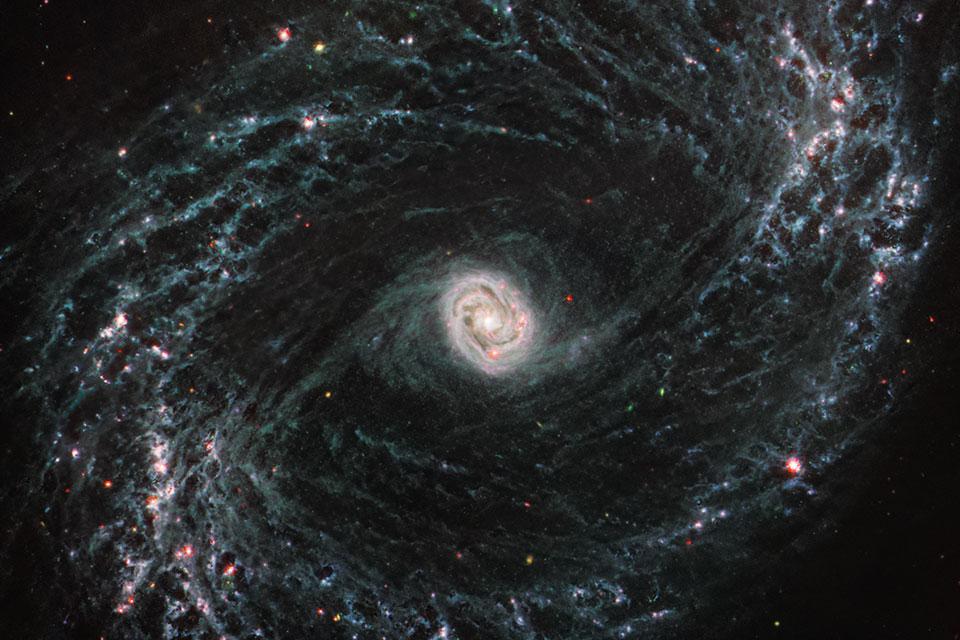New imagery from Webb’s Mid-Infrared Instrument is revealing never-before-seen details into how young, newly forming stars influence the structure of the gas and dust of nearby galaxies, and therefore how they evolve over time. Areas of galaxies that once appeared dim and dark in visible light, now under Webb’s infrared eye, are glowing cavities and huge cavernous bubbles of gas and dust.
The telescope gives unprecedented resolution at infrared wavelengths and the data has enabled an initial collection of 21 research papers which provide new insight into how some of the smallest-scale processes in our universe – the beginnings of star formation – impact the evolution of the largest objects in our cosmos: galaxies.
Largest survey of nearby galaxies
The largest survey of nearby galaxies in Webb’s first year of science operations is being carried out by the Physics at High Angular resolution in Nearby Galaxies (PHANGS) collaboration, involving more than 100 researchers from around the globe including Dr Thomas Williams from the University of Oxford. The Webb observations are led by Janice Lee, Gemini Observatory chief scientist at the National Science Foundation’s NOIRLab and affiliate astronomer at the University of Arizona in Tucson.
‘The amazing resolution and sensitivity of the James Webb Space Telescope is finally allowing us to pinpoint where stars are starting to form in galaxies,’ explains Dr Williams who led one of the initial 21 research papers and was a key member of the data processing team that readied these unparalleled images for science. ‘Using Webb’s Mid-Infrared Instrument (MIRI), we can locate the very youngest stars enshrouded in their dusty birth clouds. We now have strong evidence that stars are not just forming in the distinctive spiral arms, but all over the galaxy, and that spiral arms may not be as important for star formation as we have previously thought.’
A diverse sample
The team is studying a diverse sample of 19 spiral galaxies, and in Webb’s first few months of science operations, observations of five of those targets – M74, NGC 7496, IC 5332, NGC 1365, and NGC 1433 – have taken place.
‘The PHANGS team has spent years observing these galaxies at optical, radio, and ultraviolent wavelengths using NASA’s Hubble Space Telescope, the Atacama Large Millimeter/Submillimeter Array, and the Very Large Telescope’s Multi Unit Spectroscopic Explorer,’ added team member Adam Leroy of the Ohio State University. ‘But, the earliest stages of a star’s lifecycle have remained out of view because the process is enshrouded within gas and dust clouds.’
Powerful infrared capabilities
Webb’s powerful infrared capabilities can pierce through the dust to connect the missing puzzle pieces. Specific wavelengths observable by MIRI (7.7 and 11.3 microns) are sensitive to emission from polycyclic aromatic hydrocarbons, which play a critical role in the formation of stars and planets. These molecules were detected by Webb in the first observations by the PHANGS program. Studying these interactions at the finest scale can help provide insights into the larger picture of how galaxies have evolved over time.
‘Because these observations are taken as part of what’s called a treasury program, they are available to the public as they are observed and received on Earth,’ said Eva Schinnerer of the Max Planck Institute for Astronomy in Heidelberg, Germany, and leader of the PHANGS collaboration.
The research by the PHANGS team is being conducted as part of General Observer program 2107. The team’s initial findings, comprised of 21 individual studies, have been published in a special focus issue of The Astrophysical Journal Letters.

